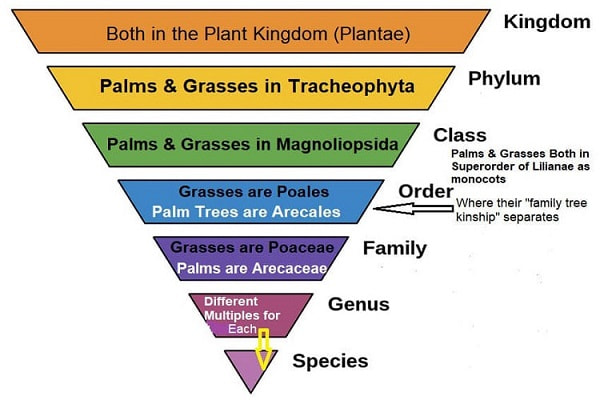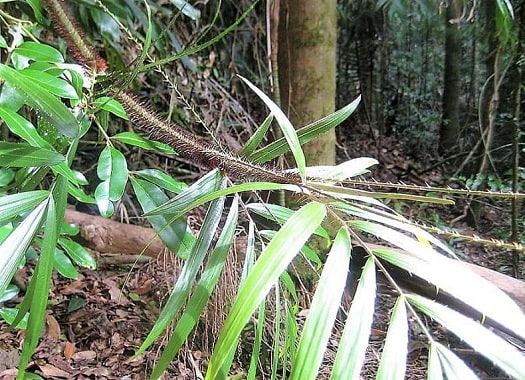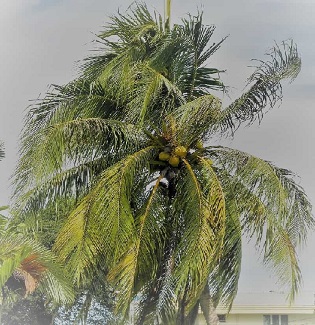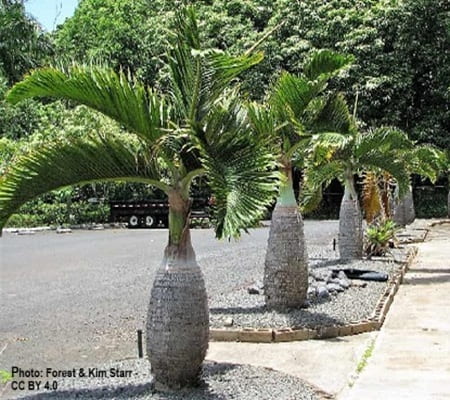- Home
- So Many Species
Palm Tree Species For You to Evaluate
Thinking through over 2,500 palm tree species can seem overwhelming! Palms are popular choices for outdoor landscaping. Or for potting to bring a tropical aura indoors.
But which is the right palm to choose? Let's look at some varied species of palms & how to sort them.
As palm tree enthusiasts, we're always learning more (as there is so much to learn!) We visit palm groves & botanical gardens, read palm tree books & Palm Tree newsletters. Seeing what's new. To get it out there for you.
Keep scrolling along, or choose your topic:
Feeling overwhelmed by so many palm trees?
You're not alone. We Understand your headaches! At Mission: Palm Trees you'll find clear answers to questions & Step-By-Step Guidance, from real people. With solutions to help. No puzzling shoptalk. No tiring research. So it's easy & fun for you.
Introduction to Palm Tree Species
Thinking of palm trees brings a certain esthetic vision, to most people's minds. Known for tall, slender trunks & their striking leaves.
Yet, they're more diverse than that. Found in many different parts of the world, with varied climates. Even though they're associated with the tropics.
Want to learn more about these fascinating plants? Our guide gives you basics to see their variety! Let's get started.

Sorting Out the Science of Palms
SOME SAY THEY'RE A TYPE OF GRASS?
Huh?! Can that be true?
Palm trees are classified in the plant family Arecaceae. They're defined by branchless stems (trunks), with large, distinct looking leaves. Their trunk is woody looking, yet it doesn't have bark.
They're not really a typical tree classification, as compared with oaks, maples, etc. They actually do have more similarities to grasses, rice & corn.
But does that mean they ARE a grass species?
Comparing Palms to Grass
Palm trees are evergreen monocots.
Palms Typically Grow from seeds, develop flowers which give way to Palm Fruit.
Some methods for identification:
Palm tree species come in all shapes & sizes. Some are small, even only getting to about 6ft/1.8m tall. Others grow to 100ft/30m plus!
Other ID practices are figuring the types & numbers of fronds, methods for growing, & specific characteristics.
For instance, asking: does this Palm Have a Crownshaft?
Palm Culture Throughout the World's History
Species of palm trees have a Rich Cultural Meaning, now & in history, throughout the world. Particularly in the tropics. Many cultures use their fruit as table food or for animal feed. Middle Eastern countries, in particular have deep cultural implications regarding palm tree species.
Since they're associated with tropical climates, they awaken Palmy Beach Sunsets in travel plans, art or memories!
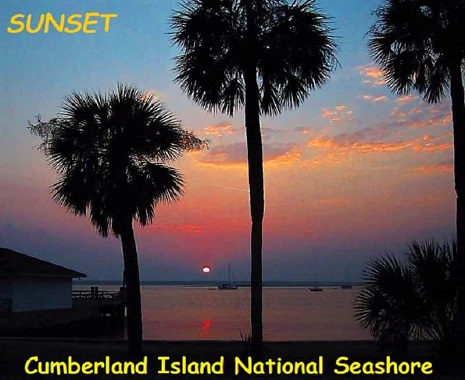 Liking this Georgia Sunset Memory!
Liking this Georgia Sunset Memory!Review Varied Palm Tree Species Categories
Some palm tree species are well-known, such as The Coconut Palm. Most are known by their common names. Others are overlooked, but quite fascinating. Sadly, some palm species are endangered, others have become extinct.
We'll guide you to some of the unique, the humble, the popularly common & the weird! Likely some palm tree species you may not have heard of before.
Palm tree species can be categorized several ways.
GROWING METHODS OF PALM SPECIES
Think of the way palms grow to organize which species they are. Two most common methods are Solitary and Clustering.
What are Solitary Palm Trees?
Probably what initially comes to mind for palms. They have one single trunk. The leaves/fronds grow out from trunk's top, with no branches.
- They're more vulnerable to high wind damage, like with hurricanes.
- They succeed in multiple types of climates.
 Being Solitary Near Solitary Palms
Being Solitary Near Solitary PalmsWhat is Meant By Clustering Palms?
They grow in clumps.
Meaning these palm tree species grow multiple trunks alongside the single original base. They spread outward with these newer trunks.
- They're popular, having a lush appearance.
- Depending on the palm tree species, useful as hedging or a Landscape Focal Point.
Nicknamed Mangrove Fan Palm.
Organizing Palms by Types of Leaves
Palm species have two common types of fronds. Knowing these is basic to Palm Tree Identification:
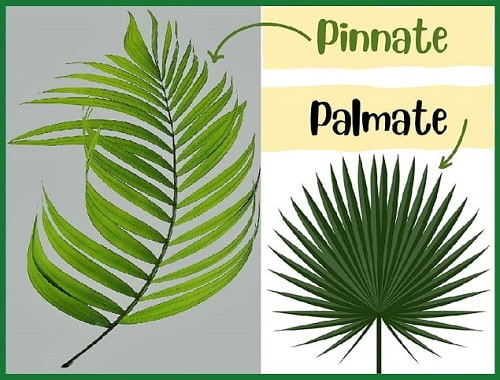
Difference Between Pinnate and Palmate Fronds
- Pinnate Fronds - Commonly called Feather Palms. Because their leaves remind you of large green feathers.
- Many leaflets grow along a stem. For a delicate, graceful look.
- Palmate Fronds - Commonly called Fan Palms. Their fronds are typically fan-shaped & quite large.
- Their look also appears like the palm of your hand, with fingers spread out. Which is how they're named.
See These Pinnate Palm Tree Species
The Areca Palm Genus
Approximately sixty species of palms in the Areca genus. They all Have Crownshafts. And the feathery pinnate fronds.
Areca guppyana Palm Tree Species
Native to New Guinea & Solomon Island rainforests.
Not commonly found in a landscape. But locally used to substitute for the Betal Nut Palm.
- As seen here, its narrow trunk is supported by stilt roots.
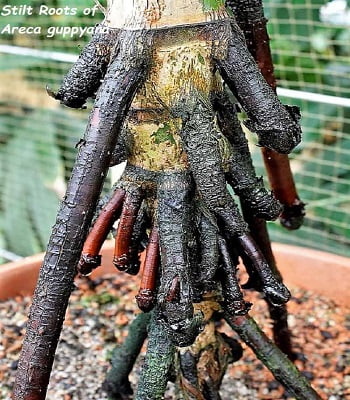 This Areca has prop roots supporting a narrow trunk.
This Areca has prop roots supporting a narrow trunk.Photo: Pavel Hrdlicka - CC BY-SA 4.0
The stunning, yet small Areca ridleyana
A beautiful ornamental stunner.
Endemic to Malaysian rainforest hills, growing beneath taller plants. Thus needs shady areas.
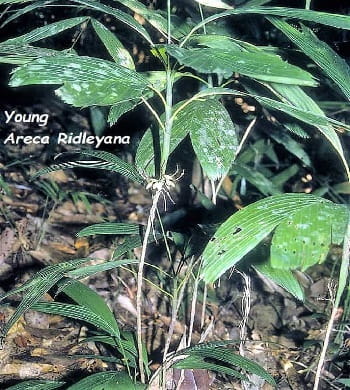 Credit: Scott Zona - CC BY 4.0
Credit: Scott Zona - CC BY 4.0Dypsis lutescens Has a Confusing Common Name
Commonly called the Areca Palm.
It's actually not in the Areca genus as you can see with the genus name: Dypsis. It's also known as Golden Cane Palm Tree & Butterfly Palm.
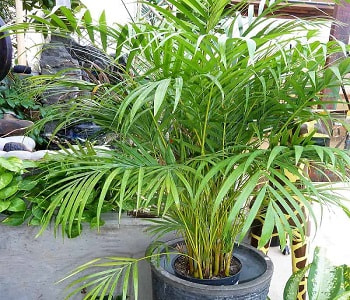 Potted Areca-Like Palm
Potted Areca-Like PalmPhoto: kmoore @Flickr - CC BY 4.0
Calamus muelleri - A different Type of Palm Tree Species
Native to Eastern Queensland & New South Wales Rainforests. Locally called Southern Lawyer Cane. Also called Wait-A-While.
- A clustering palm growing with a climbing method. Most in the Calamus genera do that. They climb up forest vegetation, like a vine.
- Their spines help them attaching to plants.
- Probably the most cold-hardy of all Calami rattans.
Chamaedorea elegans - Very Popular as an Indoor Palm
Common names are Neanthe Bella or Parlor Palm Tree. Probably the most popular palm tree species for indoors. It tolerates shady spots well.
- The small yellow flowers add to its attraction.
- Some use it outdoors as a tall groundcover!
Chamaedorea radicalis
Sometimes called the Mexican Parlor Palm or Hardy Parlour Palm.
- Endemic to oak forest foothill climes of northeastern Mexico. Known for survival in Zones 8-11.
- Looks trunkless because it's underground. Why it's used as ground cover.
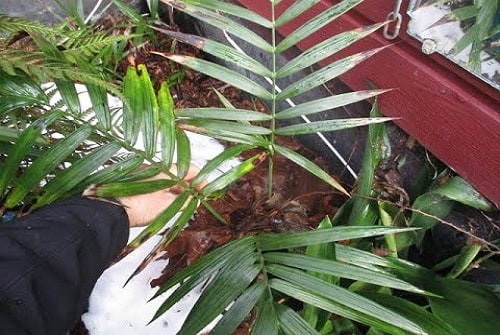 Where's the Trunk of the Hardy Parlour Palm?
Where's the Trunk of the Hardy Parlour Palm?Cocos nucifera v. Malayan Dwarf
Commonly called Dwarf Coconut Palm, Malayan Dwarf Coconut Palm or Pygmy Coconut has edible coconuts. Zones 10b-11.
- This Malayan strain of the Coconut Palm Tree was developed for resistance to lethal yellowing disease.
Beautifully colorful Cyrtostachys renda
Known as Lipstick Palm, Sealing Wax Palm, Maharajah Palm & Pinang Rajah.
- A colorful contrast makes this a brilliant palm tree species specimen. The frond stem, bases & crownshaft are a dazzling glossy red. Dark green feathery leaflets provide contrast.
- Needs much water & tropical warmth.
- Easiest growing: potted as an Indoor Palm.
 We Enjoy the Lipstick Nam! Do You?
We Enjoy the Lipstick Nam! Do You?Photo: Moebiusuibeom-en - CC BY-SA 4.0
Dypsis decaryi - A Unique, Stunning Palm Species
Known as the Triangle Palm.
You'll discover why, because of the eye-catching triangular shape of its bright green fronds. The trunk has a distinctive rough texture.
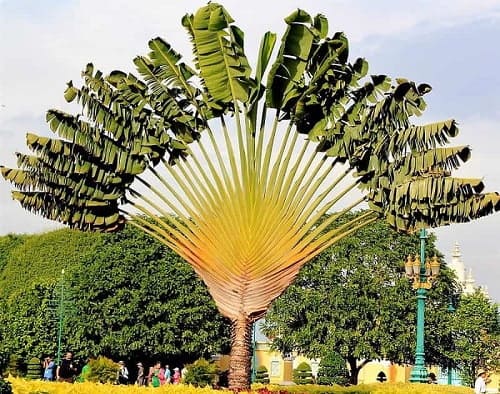 We Think You Now Know How it Got That Common Name!
We Think You Now Know How it Got That Common Name!Elaeis guineensis - The African Oil Palm
Even though 25 feet tall, it's massive because of the full round crown.
- With 15ft/4.5m long fronds having 3-5ft/90-150cm leaflets.
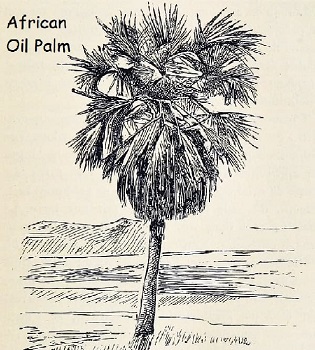 Vintage Palm Tree Artwork
Vintage Palm Tree Artwork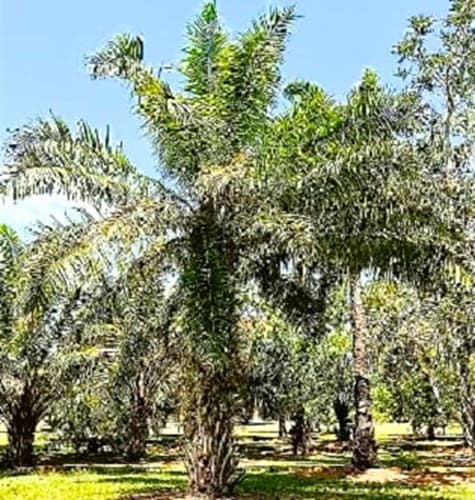 African Oil Palm "immigrant" 😁 in Florida!
African Oil Palm "immigrant" 😁 in Florida!Fishtail Palm Trees Have a Unique Frond Look
A genera with 12 palm tree species.
- With another type of leaf form: bipinnate leaflets resembling fish tails.
- Caryota mitis: It's truly the ONE called the Fishtail Palm.
- Crams thickly out to 15ft/4.5m wide in clusters. Slender stems grow to 30ft/9m tall.
- With regular watering, grows relatively quickly.
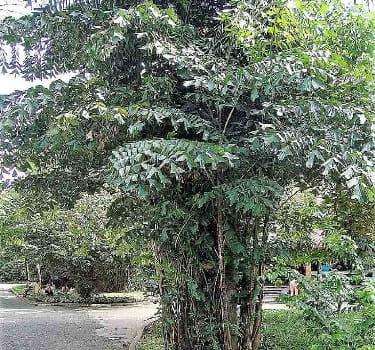 Impressive Growth in a Thick Clump!Photo: Prenn - CC BY-SA 4.0
Impressive Growth in a Thick Clump!Photo: Prenn - CC BY-SA 4.0Hyophorbe lagenicaulis - the Stunning Looker
Called the Bottle Palm or Belly Palm. Small, unique palm species native to Indian Ocean's Mascarenes.
- Lower trunk has a distinctive shape. Reminding you of a bottle or a beer belly!
- Only gets about 30ft/9m max. Tiny white flowers bring small, red fruits.
- Becoming a popular ornamental, this handsome species is natively endangered. Because of over-harvesting, plus natural habitat loss.
Hyophorbe verschaffeltii - The Spindle Palm
Sometimes called the Spindle Bottle Palm.
Native to the island of Mauritius.
The smooth, gray trunk is reminiscent of a spindle: narrow at the bottom & top, swelling a bit in between. Above is a vividly green crownshaft. Relatively hardy, yet slow-growing.
- Grows to 40ft/12m tall. Small red fruit follows tiny white flowers.
- A very popular landscape plant. Now endangered in the wild.
- One saving grace you can Easily Grow It From Seed.
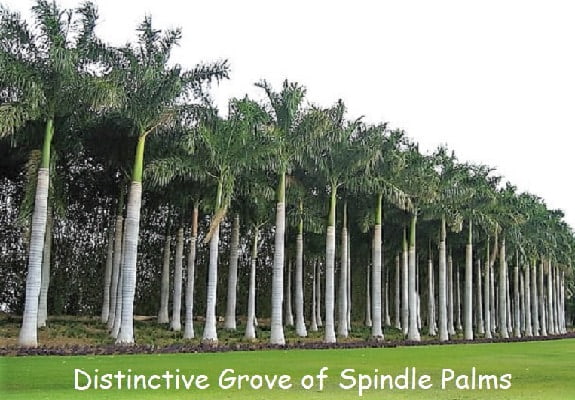
Ravenea rivularis - the Majestic Palm
Usually called Majesty Palm Tree is practical for indoors, but is also fabulous outdoors.
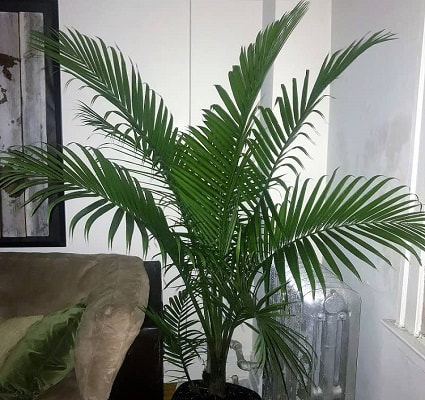 The Majestic Palm as a Houseplant
The Majestic Palm as a HouseplantPhoto: Glpinagelpinagel - CC BY-SA 4.0
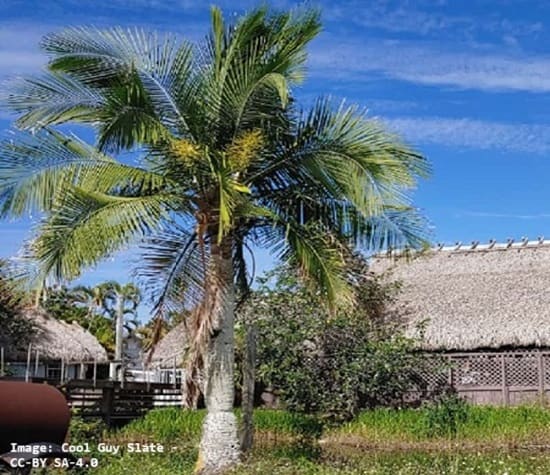 Outdoors the Majesty Palm Palm Tree common name reflects it well!
Outdoors the Majesty Palm Palm Tree common name reflects it well!ROYAL PALM TREE
About 12 palm tree species in this category. All native to the Caribbean.
Roystonea regia - The Royal Palm icon
AKA Cuban Royal Palm.
A solitary grower, pretty quickly to 100ft/30m tall. Light gray trunk topped off with a dark green tapering crownshaft.
- Very impressive flower inflorescences (stalks) grow upwards.
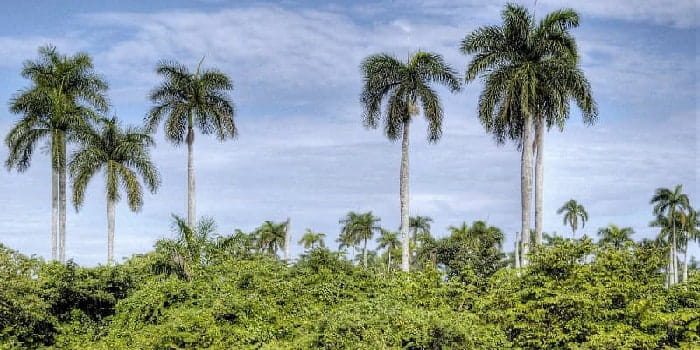 Cuban Royal Palms Scattered Around Marabu - In Cuba!
Cuban Royal Palms Scattered Around Marabu - In Cuba!Photo: Angel M Felicisimo - CC BY-SA 4.0
Syagrus romanzoffiana - The Queen!
Queen Palm Trees natively are solitary, quickly getting up to 90ft/27m tall.
- Typically like Zones 9-11 best, with good sun & lots of watering.
- Even grows easily from seed.
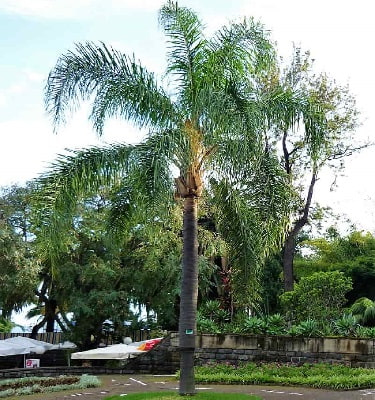 This Queen Palm Tree is Quite a Looker!
This Queen Palm Tree is Quite a Looker!Photo: Funchal Pasztorperc - CC BY-SA 4.0
See These Gorgeous Palmate Palm Tree Species
Bismarckia nobilis is So Handsome!
The popular, Bismarck Palm Tree is loved for huge, silver-blue fan fronds.
Relatively drought-hardy.
- The impressive trunk gets up to 18in/45cm thick. Patterned with grayish-brown diamond-shaped leaf scars.
- In 9b-11 Zones, Landscaping Planning often makes use of this palm tree species.
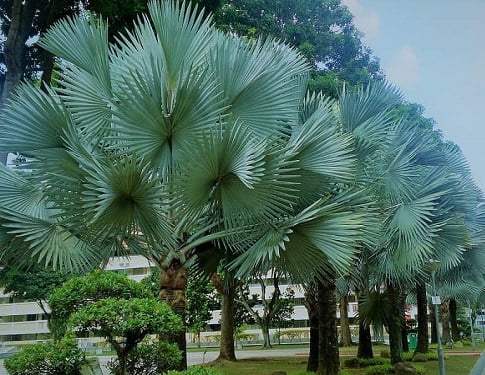 Bismarck Palm Placement was done Just Right!
Bismarck Palm Placement was done Just Right!Don't You Think?
Photo: Mokkie - CC BY-SA 4.0
Brahea decumbens is a Sun Lover
Called the Mexican Dwarf Blue Palm or Sierra Madre Palm.
Native to scrubby areas of Northeastern Mexico. Clustering growth in a "recumbent" manner, slowly sliding along the ground.
- It can make a nice groundcover, though a bit tall.
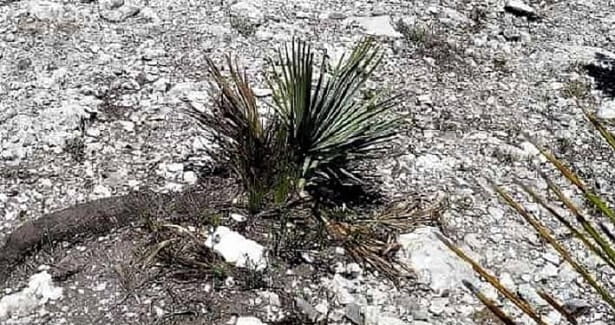 Trying to Find the Trunk/Stem? No - Look Closely!
Trying to Find the Trunk/Stem? No - Look Closely!Photo: Sergio Niegla #Flickr - CC BY-SA 4.0
Chamaerops humilis - The European Fan Palm
Also goes by Mediterranean Fan Palm.
- Usually clustering, spreading to 30ft/9m. Maxes about 20ft/6m high.
- Survives Zones 8-11. Not fussy, except doesn't like wet/humidity.
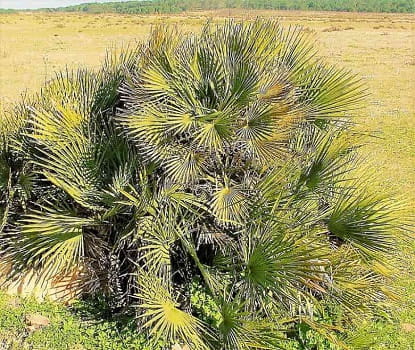 This Palm is Fairly Cold Hardy
This Palm is Fairly Cold HardyDoesn't Need Much Rain Either!
Livistona chinensis - The Chinese Fan Palm
Relatively short, slow growing & easily managed.
Can range from tropics (9-11) to temperate areas. And with protective watchfulness: Zone 8b.
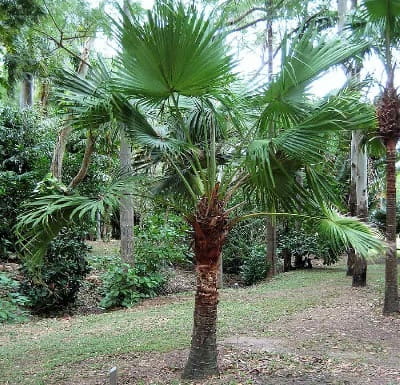 Chinese Fan Palm At Cooktown Botanic Gardens, Queensland, Australia
Chinese Fan Palm At Cooktown Botanic Gardens, Queensland, AustraliaPhoto: Lokal Profil - CC BY-SA 4.0
Rhapis excelsa - The Popular Indoor Palm: Lady Palm
Other common names: Bamboo Palm or Tall Lady Palm.
Naturally clustering out as tall (12ft/4m) as it's wide.
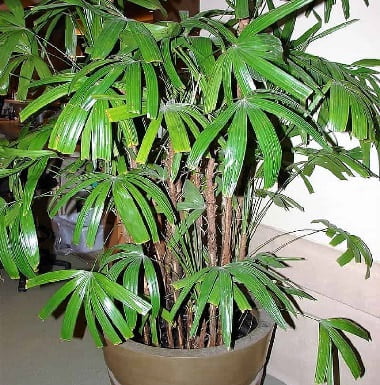 Lady Palm Greets Guest Indoors
Lady Palm Greets Guest IndoorsAt Oahu's Ala Moana Hotel, Hawaii
Photo: Forest & Kim Starr - CC BY 4.0
Newest Palm Article
-
Best Palm Trees for Arizona - Which to Choose for Your Landscape
The best palm trees for Arizona can nicely fit many landscapes. We show you hardy and resilient palm trees that do well under the Arizona sun.
Washingtonia robusta
Multiple common names are Mexican Palm Tree, Washington Palm, Mexican Fan Palm & Skyduster.
- Popular Tall Palm Species for outdoor street & city landscapes in the Southwest.
- Native to canyon washes & springs of Sonora & Baja California, Mexico.
Some make the comparison of Washingtonia filifera vs robusta (see their looks below). The filifera isn't Native to Southern California. Unlike robusta which is native to So-Cal, Western Arizona & Baja California.
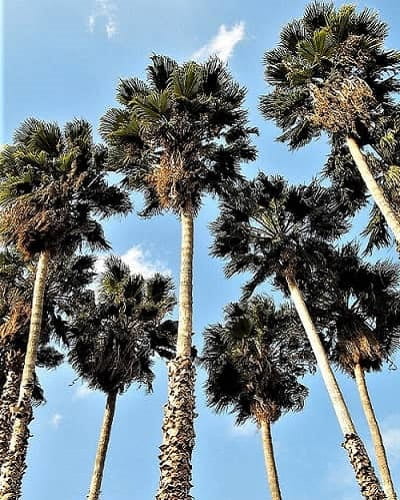 Tall Mexican Fan Palms at LA Botanic Garden
Tall Mexican Fan Palms at LA Botanic GardenCompare the Look of Washingtonia filifera vs robusta
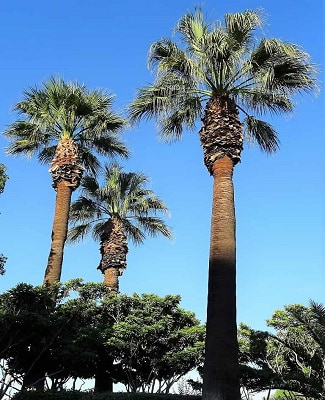 Filifera Has a Much Thicker Trunk
Filifera Has a Much Thicker Trunk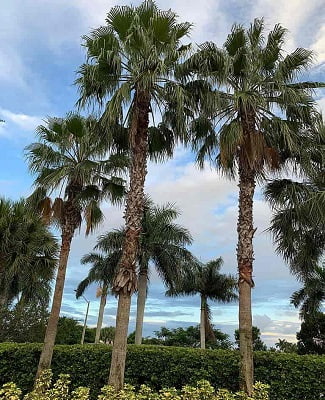 2 robusta Species Grow Tall in Florida
2 robusta Species Grow Tall in FloridaPhoto: Katherine Wagner-Reiss
CC BY-SA 4.0
Takeaways for palm tree species
You've seen there are several ways to categorize palm tree species.
Knowing that can help you decide on a suitable palm to grow yourself. Or not! It's also the beginning for figuring out palm identification.
